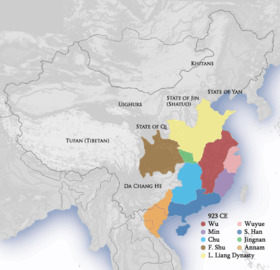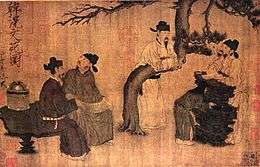Ten Kingdoms
| Ten Kingdoms | |||||||
 | |||||||
| Traditional Chinese | 十國 | ||||||
|---|---|---|---|---|---|---|---|
| Simplified Chinese | 十国 | ||||||
| |||||||
The Ten Kingdoms was a period in the history of Southern China that followed the fall of the Tang dynasty in 907. It lasted until the rise of the Song dynasty, which was founded in 960. Nine of the kingdoms were in the South and one small kingdom was in the far North. Many states were de facto independent long before the Tang Empire dissolved. The last of the Ten Kingdoms, the Northern Han, survived until 979.
Unlike the Five Dynasties of northern China, which succeeded one other in rapid succession, the regimes of South China were generally concurrent, each controlling a specific geographical area. Each court was a center of artistic excellence. The period is noted for the vitality of its poetry and for its economic prosperity. Commerce grew so quickly that there was a shortage of metallic currency. This was partly addressed by the creation of bank drafts, or "flying money" (feiqian), as well as by certificates of deposit. Wood block printing became common during this period, 500 years before Johannes Gutenberg's press.
Number of kingdoms
The Ten Kingdoms were:
- Wu (907–37)
- Wuyue (907–78)
- Min (909–45)
- Chu (907–51)
- Southern Han (917–71)
- Former Shu (907–25)
- Later Shu (934–65)
- Jingnan (924–63)
- Southern Tang (937–75)
- Northern Han (951–79).
Only ten are traditionally listed, hence the era's name. Some historians, such as Bo Yang, count eleven, including Yan and Qi but not the Northern Han, viewing it as simply a continuation of Later Han. This era also led to the founding of the Liao dynasty in the north.
Other regimes during this period were Yan, Qi, Zhao, Yiwu Jiedushi, Dingnan Jiedushi, Wuping Jiedushi, Qingyuan Jiedushi, Yin, Ganzhou, Shazhou, and Liangzhou.
Wu
 | |||||||
|---|---|---|---|---|---|---|---|
| ANCIENT | |||||||
| Neolithic c. 8500 – c. 2070 BCE | |||||||
| Xia dynasty c. 2070 – c. 1600 BCE | |||||||
| Shang dynasty c. 1600 – c. 1046 BCE | |||||||
| Zhou dynasty c. 1046 – 256 BCE | |||||||
| Western Zhou | |||||||
| Eastern Zhou | |||||||
| Spring and Autumn | |||||||
| Warring States | |||||||
| IMPERIAL | |||||||
| Qin dynasty 221–206 BCE | |||||||
| Han dynasty 206 BCE – 220 CE | |||||||
| Western Han | |||||||
| Xin dynasty | |||||||
| Eastern Han | |||||||
| Three Kingdoms 220–280 | |||||||
| Wei, Shu and Wu | |||||||
| Jin dynasty 265–420 | |||||||
| Western Jin | |||||||
| Eastern Jin | Sixteen Kingdoms | ||||||
| Northern and Southern dynasties 420–589 | |||||||
| Sui dynasty 581–618 | |||||||
| Tang dynasty 618–907 | |||||||
| (Second Zhou dynasty 690–705) | |||||||
| Five Dynasties and Ten Kingdoms 907–960 |
Liao dynasty 907–1125 | ||||||
| Song dynasty 960–1279 |
|||||||
| Northern Song | Western Xia | ||||||
| Southern Song | Jin | ||||||
| Yuan dynasty 1271–1368 | |||||||
| Ming dynasty 1368–1644 | |||||||
| Qing dynasty 1644–1911 | |||||||
| MODERN | |||||||
| Republic of China 1912–1949 | |||||||
| People's Republic of China 1949–present |
Republic of China (Taiwan) 1949–present | ||||||
The Kingdom of Wu (902–937) was established in modern-day Jiangsu, Anhui, and Jiangxi. It was founded by Yang Xingmi, who became a Tang Dynasty military governor in 892. The capital was initially at Guangling (present-day Yangzhou) and later moved to Jinling (present-day Nanjing). The kingdom fell in 937 when it was taken from within by the founder of the Southern Tang.
Wuyue
The Kingdom of Wuyue was the longest-lived (907–978) and among the most powerful of the southern states. Wuyue was known for its learning and culture. It was founded by Qian Liu, who set up his capital at Xifu (modern-day Hangzhou). It was based mostly in modern Zhejiang province but also held parts of southern Jiangsu. Qian Liu was named the Prince of Yue by the Tang emperor in 902; the Prince of Wu was added in 904. After the fall of the Tang Dynasty in 907, he declared himself king of Wuyue. Wuyue survived until the eighteenth year of the Song dynasty, when Qian Shu surrendered to the expanding dynasty.
Min
The Kingdom of Min (909–945) was founded by Wang Shenzhi, who named himself the Prince of Min with its capital at Changle (present-day Fuzhou). One of Shenzhi’s sons proclaimed the independent state of Yin in the northeast of Min territory. The Southern Tang took that territory after the Min asked for help. Despite declaring loyalty to the neighboring Wuyue, the Southern Tang finished its conquest of Min in 945.
Southern Han
The Southern Han (917–971) was founded in Guangzhou (also known as Canton) by Liu Yan. His brother, Liu Yin, was named regional governor by the Tang court. The kingdom included Guangdong, Guangxi, Hanoi, and Hainan.
Chu
The Chu (927–951) was founded by Ma Yin with the capital at Changsha. The kingdom held Hunan and northeastern Guangxi. Ma was named regional military governor by the Tang court in 896, and named himself the Prince of Chu with the fall of the Tang in 907. This status as the Prince of Chu was confirmed by the Later Tang in 927. The Southern Tang absorbed the state in 951 and moved the royal family to its capital in Nanjing, although Southern Tang rule of the region was temporary, as the next year former Chu military officers under the leadership of Liu Yan seized the territory. In the waning years of the Five Dynasties and Ten Kingdoms period, the region was ruled by Zhou Xingfeng.
Northern Han
The Northern Han was founded by Liu Min (劉旻), formerly known as Liu Chong (劉崇), and lasted from 951 to 979. It has the capital at Taiyuan.
Jingnan (also known as Nanping)
The smallest of the southern states, Jingnan (924–963), was founded by Gao Jichang. It was based in Jiangling and held two other districts southwest of present-day Wuhan in Hubei. Gao was in the service of the Later Liang (the successor of the Tang in North China). Gao’s successors claimed the title of King of Nanping after the fall of the Later Liang in 924. It was a small and weak kingdom, and thus tried to maintain good relations with each of the Five Dynasties. The kingdom fell to advancing armies of the Song in 963.
Former Shu
Former Shu (907–25) was founded after the fall of the Tang Dynasty by Wang Jian, who held his court in Chengdu. The kingdom held most of present-day Sichuan, western Hubei, and parts of southern Gansu and Shaanxi. Wang was named military governor of western Sichuan by the Tang court in 891. The kingdom fell when his son surrendered in the face of an advance by the Later Tang in 925.
Later Shu
The Later Shu (935–965) is essentially a resurrection of the previous Shu state that had fallen a decade earlier to the Later Tang. Because the Later Tang was in decline, Meng Zhixiang found the opportunity to reassert Shu’s independence. Like the Former Shu, the capital was at Chengdu and it basically controlled the same territory as its predecessor. The kingdom was ruled well until forced to succumb to Song armies in 965.
Southern Tang

The Southern Tang (937–975) was the successor state of Wu as Li Bian (Emperor Liezu) took the state over from within in 937. Expanding from the original domains of Wu, it eventually took over Yin, Min, and Chu, holding present-day southern Anhui, southern Jiangsu, much of Jiangxi, Hunan, and eastern Hubei at its height. The kingdom became nominally subordinate to the expanding Song in 961 and was invaded outright in 975, when it was formally absorbed into Song China.
Transitions between kingdoms
Although more stable than northern China as a whole, southern China was also torn apart by warfare. Wu quarrelled with its neighbours, a trend that continued as Wu was replaced with Southern Tang. In the 940s Min and Chu underwent internal crises which Southern Tang handily took advantage of, destroying Min in 945 and Chu in 951. Remnants of Min and Chu, however, survived in the form of Qingyuan Jiedushi and Wuping Jiedushi for many years after. With this, Southern Tang became the undisputedly most powerful regime in southern China. However, it was unable to defeat incursions by the Later Zhou between 956 and 958, and ceded all of its land north of the Yangtze River.
The Song dynasty, established in 960, was determined to reunify China. Jingnan and Wuping Jiedushi were swept away in 963, Later Shu in 965, Southern Han in 971, and Southern Tang in 975. Finally, Wuyue and Qingyuan Jiedushi gave up their land to Northern Song in 978, bringing all of southern China under the control of the central government.
In common with other periods of fragmentation, the Five Dynasties and Ten Kingdoms period resulted in a division between northern and southern China. The greater stability of the Ten Kingdoms, especially the longevity of Wu Yue and Southern Han, would contribute to the development of distinct regional identities within China.
See also

- Annam (Chinese province)
- Family trees of the emperors of the Five Dynasties
- Chinese sovereign
- Liao dynasty
- Conquest of Southern Tang by Song
- Zizhi Tongjian
Further reading
- Dudbridge, Glen (2013). A Portrait of Five Dynasties China: From the Memoirs of Wang Renyu (880-956). Oxford University Press. ISBN 978-0199670680.
- Kurz, Johannes L. (2011). China's Southern Tang Dynasty (937-976). Routledge. ISBN -9780415454964.
- Lorge, Peter, ed. (2011). Five Dynasties and Ten Kingdoms. The Chinese University Press. ISBN 962996418X.
- Ouyang Xiu (2004) [1077]. Historical Records of the Five Dynasties. (transl. Richard L. Davis). New York: Columbia University Press. ISBN 0-231-12826-6.
- Schafer, Edward H. (1954). Empire of Min: A South China Kingdom of the Tenth Century. Tuttle Publishing.
- Wang Gungwu (1963). The Structure of Power in North China During the Five Dynasties. Stanford University Press.
- Wang Hongjie (2011). Power and Politics in Tenth-Century China: The Former Shu Regime. Cambria Press. ISBN 1604977647.
| Wikimedia Commons has media related to Five Dynasties and Ten Kingdoms. |
| Preceded by Tang dynasty |
Dynasties in Chinese history 907–960 |
Succeeded by Song dynasty Liao dynasty |